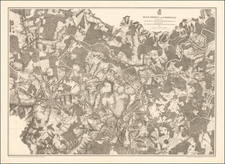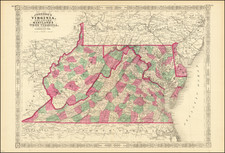Virginia Chiefs
Fine copperplate engraving showing Theodore De Bry's version of John White's painting "A Picture of the Rulers of Virginia."
The view shows two tattoed Virginia Indians with bows, with additional hunters in the background. The text translates as follows:
The chiefs of Virginia appear in public in the manner depicted in this figure. They nourish the hair of the head, tying the ends in a knot under the ear; however, they shave the top of the head from the forehead to the back in the manner of a rooster's comb. They place a long feather of some elegantly colored bird at the beginning of the crest above the forehead, and shorter ones on both sides behind the ears. They hang either rather thick pearls or something else, like the large foot of some bird, from their ears, as it comes into their minds. Moreover, they decorate or paint the forehead, cheeks, chin, and even the body, arms, and legs with punctured designs, though in a different manner than the inhabitants of Florida. They wear a torque made from pearls or beads of sand around their neck, and armlets of the same on their arms. A mark appears next to the stomach under the chest, where they are accustomed to make an incision for the letting of blood when they are seized with illness. They attach to the front of the body the elegantly arranged skin of some wild animal in such a way that its tail hangs down behind the buttocks. They carry a quiver made from slender reeds, holding a tense bow in one hand and an arrow in the other, prepared for defense. They proceed with this attire either into war or to some solemn and celebrated feast. They take great pleasure in deer hunting, of which there is a large quantity in that province; for it is fertile, pleasant, and wooded. It also abounds in rivers full of fish of various kinds. When they are setting out for war, they paint their bodies in a manner as frightening as possible.
In 1585, Governor John White, was part of a voyage from England to the Outer Banks of North Carolina under a plan of Sir Walter Raleigh to settle "Virginia." White was at Roanoke Island for about thirteen months before returning to England for more supplies. During this period he made a series of over seventy watercolor drawings of indigenous people, plants, and animals. The purpose of his drawings was to give those back home an accurate idea of the inhabitants and environment in the New World. The earliest images derived from White's original drawings were made in 1590, when Theodor De Bry made engravings from White's drawings to be printed in Thomas Hariot's account of the journey. Hariot, a mathematician, had also been part of the 1585 voyage.
Theodor de Bry (1528-1598) was a prominent Flemish engraver and publisher best known for his engravings of the New World. Born in Liege, de Bry hailed from the portion of Flanders then controlled by Spain. The de Brys were a family of jewelers and engravers, and young Theodor was trained in those artisanal trades.
As a Lutheran, however, his life and livelihood were threatened when the Spanish Inquisition cracked down on non-Catholics. De Bry was banished and his goods seized in 1570. He fled to Strasbourg, where he studied under the Huguenot engraver Etienne Delaune. He also traveled to Antwerp, London, and Frankfurt, where he settled with his family.
In 1590, de Bry began to publish his Les Grands Voyages, which would eventually stretch to thirty volumes released by de Bry and his two sons. The volumes contained not only important engraved images of the New World, the first many had seen of the geographic novelties, but also several important maps. He also published a collection focused on India Orientalis. Les Grands Voyages was published in German, Latin, French, and English, extending de Bry’s fame and his view of the New World.










![[ The King of Florida ] Der Konig in Florida](https://storage.googleapis.com/raremaps/img/small/94085.jpg)

![(Aztec Tribute List) [Original watercolor showing tribute items paid to the Aztecs by subject towns] Mendoza Col. part 1s Lorenzana, Aglio 1, Vol 22...](https://storage.googleapis.com/raremaps/img/small/102321.jpg)
![[Original photograph] Native Americans, possibly Creeks, in outdoor camp with white settlers or Indian Agents.](https://storage.googleapis.com/raremaps/img/small/78740.jpg)
